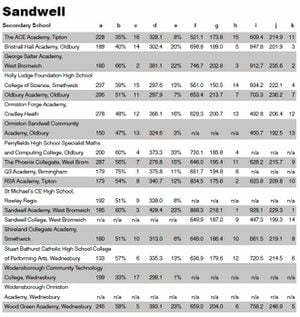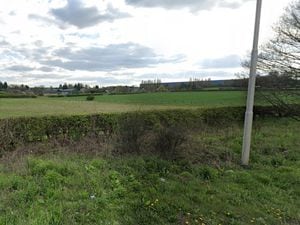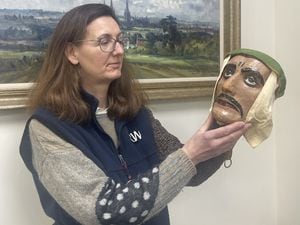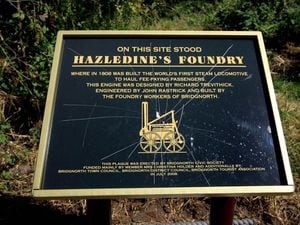Black Country and Staffordshire secondary school league tables
While it was good news for Dudley, Walsall slipped further down the rankings. Find out how your school fared in the rankings below.

The number of secondary schools considered to be under-performing has doubled in the wake of a major overhaul of the exams system, new figures show.
More than 300 schools fell beneath the Government's floor target this year after failing to ensure that enough pupils gained five good GCSE grades and made decent progress in the basics, according to an analysis of new league tables. The Department for Education (DfE) insisted that the rise is down to two key reforms.
These are, firstly, the decision that only pupils' first attempt at a GCSE would count in the tables, and second, a move to drop 'poor quality' vocational qualifications from the rankings.
But education leaders have voiced fears that schools will be considered failing not just due to changes in the system, but also as a result of 'volatility' in last summer's GCSE results.
The new league tables, published today, are based on data provided by the DfE and show how every school and college in England performed at GCSE, A-level and other academic and vocational qualifications in 2014.
They also indicate that dozens of secondaries – including St Peter's Collegiate CofE School in Wolverhampton – have seen their results plummet to zero because some combinations of English GCSEs and some international GCSEs do not count this year.
State secondaries are considered to be below the Government's floor target if less than 40 per cent of their pupils gain at least five C grades at GCSE, including English and maths.
Nationally 330 schools fell below the benchmark this year, up from 154 last year. The DfE insisted that the floor standard is one of a number of factors that schools are judged on and falling below the benchmark does not automatically mean that a school will face intervention.
Education Secretary Nicky Morgan said: "By stripping out thousands of poor quality qualifications and removing resits, some schools have seen changes in their standings. But fundamentally young people's achievement matters more than being able to trumpet ever higher grades."
[breakout title="KEY: This page shows every secondary school, listed by local education authority area. Left to right, after the name and type of school, the columns show:
Key Stage 4: GCSEs and equivalent qualifications."] a. The number of pupils eligible for GCSE and equivalent qualifications. This is defined as the number of pupils at the end of Key Stage 4, which usually means all pupils in Year 11.
b. The proportion of candidates getting five or more A* to C-grades at GCSE or equivalent including English and maths.
c. The rank within its local authority which the school achieved according to the proportion of pupils getting five or more A* to C-grades at GCSE or equivalent including English and maths. Ties are broken by average GCSE points score per pupil.
d. The total average points score per pupil. GCSEs and qualifications judged to be equivalent to GCSEs are assigned points. For example, a GCSE, grade B = 46 points; BTEC Certificate in Applied Science, Distinction = 52.
e. The percentage of pupils achieving the English Baccalaureate (EBacc). To achieve the EBacc a pupil must get at least a C grade at GCSE in English, maths, science, a humanities subject (history or geography) and foreign language.
Key Stage 5: A-levels, other academic and vocational qualifications.
f. The average points score per full-time equivalent academic student at the end of Key Stage 5 (which usually means pupils in Year 13). This includes those taking courses such as A-levels and the International Baccalaureate.
g. The average point score per academic entry.
h. The rank within its local authority the school or college achieved according to its points score per academic student. Ties are broken by the average points score per academic entry.
i. The average points score per full-time equivalent vocational student at the end of Key Stage 5 (which usually means pupils in Year 13). This includes those taking courses such as BTECs and NVQs.
j. The average points score per vocational entry.
k. The rank within its local authority the school or college achieved according to its points score per vocational student. Ties are broken by the average number of points score per vocational entry.
l Care should be taken when comparing results for schools with small numbers of pupils eligible for the exams. Schools with five or fewer eligible pupils will have their data suppressed and n/a given instead.
l A number of secondary schools have become academies. In these cases schools may be listed twice – once under their old name and status, with their exam results and once under their new status. The new academies will have n/a for their results. The Department for Education's performance tables website. New schools – such as new free schools – may also not have results listed, with n/a given instead.
l Some schools and colleges may not cater to either GCSE or A-level pupils, for example they may be an 11-16-year-old school, or a further education college. Others may not have entered pupils for GCSEs or A-levels and other qualifications, or both, or their results may not have been published. In these cases these columns state n/a.
Wolverhampton - Girls shine in GCSEs
It was celebration time at Wolverhampton Girls' High School as the school once again finished top of the pile in the city for GCSE results.
All 108 pupils who took GCSEs last year gained the Government's benchmark of five or more A*-C grades including English and maths. The school also performed best in the city for A-level results.
The school's performance was in stark contrast to the city's overall results, which saw the authority slump to 145th in the country with just 46.4 per cent of pupils achieving benchmark grades.
Trudi Young, headteacher of Wolverhampton Girls' High, said: "
Our girls enjoyed great success as a result of their hard work, commitment and dedication, alongside the support of their teachers and their families. We are very proud."
The was also success for Wolverhampton Grammar School, which repeated last year's second place standing.
Moseley Park in Bilston continued its remarkable improvement with 76 per cent of pupils scoring five or more GCSEs at grade C or higher.
The school was in special measures in 2010 but has risen steadily up the ranks since then, and now sits third best of the city's schools.
St Peter's Collegiate CofE School has been given zero per cent as a result of problems with how the school's English GCSE results were recorded.
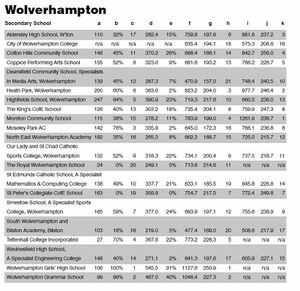
Dudley - A class act as borough is now top
Dudley came top of the pile in the Black Country for both A-level and GCSE results.
The borough was ranked 27th in the country out of 152 local authorities, based on the average points scored per student completing qualifications such as A-levels and the International Baccalaureate.
For GCSEs Dudley was ranked 114th nationally, with 53.3 per cent of pupils achieving five or more A* to C-grades including English and maths.
Old Swinford Hospital School did best in the borough with 76 per cent of pupils taking home five or more A* to C-grades at GCSE or equivalent including English and maths.
The Stourbridge-based school rose from sixth place in the rankings last year.
The school also came second in the borough for A-level results.
Redhill School also had a successful year. Of the 230 pupils eligible to take GCSE exams at the school in Junction Road, Stourbridge, 70 per cent achieved the benchmark grade.
Ellowes Hall Sports College came third for GCSE results, while Windsor High School in Halesowen was fourth.
King Edward VI College in Stourbridge led the way for A-level results.
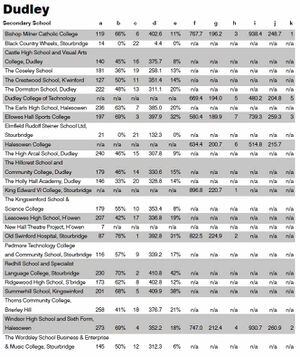
Walsall - Dismay at further slip down rankings
Walsall's education chief has admitted the council has 'failed a generation of children' after the authority slipped further down the national rankings for GCSE results.
Schools in Walsall fell from 103rd to 141st out of 152 local authorities, with education bosses admitting the borough has a 'mountain to climb' to make sure children can access a school that is good or better.
The number of pupils in Walsall achieving the Government's benchmark of five or more A*-C grades, including English and maths, dropped below the national average to 48.7 per cent in 2014, down from 58.7 per cent last year.
Councillor Barbara Cassidy, the council's lead for children's services, said that although she was disappointed in the dip in performance, she was determined to support and challenge schools to improve.
She said: "Since the Labour Group took control of the council last August my attitude to school improvement has been 'This is now my watch, so get on and improve'. The tacit acceptance of poor results and low standards, particularly in areas of high deprivation, is no longer acceptable.
"The political leadership of Walsall Council are and always have been responsible for school improvement, so it is up to us to ensure they happen – with pace and enthusiasm.
"This will mean that standards are raised which will give all Walsall children and young people the opportunities they deserve."
Despite the poor results, Councillor Cassidy said there were already signs of good progress being made.
As was the case last year, Queen Mary's Grammar School was the stand-out performer with 99 per cent of 94 pupils gaining five or more A*-C grades, including English and maths. The school also headed the borough in A-level results. Queen Mary's High School maintained its second place position with 92 per cent.
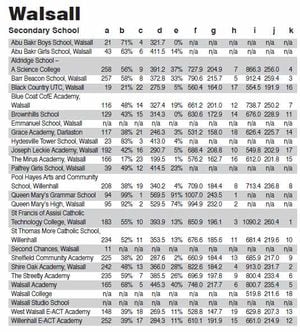
Staffordshire - Drop of five per cent for pupils hitting best results
Schools in Staffordshire saw a fall in the amount of pupils gaining five or more grade A*-C GCSEs including English and maths.
Across the county, 54.9 per cent of pupils achieved the benchmark, a drop of five per cent on last year.
The fall has led Staffordshire's education chief to reiterate previous calls for schools to take advantage of support and advice from the authority to ensure good exam results are consistent across the Staffordshire.
Councillor Ben Adams, cabinet member for learning and skills, said the fall can be explained partly by the change in the way results were recorded this year, with only pupils' first attempt at exams included in the data.
He added: "According to these results, Staffordshire children are performing above the national average. Our task now is to continue to support consistency amongst all schools in Staffordshire and concentrate on those that need extra help to improve their results.
With schools more responsible for themselves, we also see the role of governors as crucial to driving improvement."
Chase Grammar School, in Cannock, came top of the pile across the county, while Stafford Grammar School was second best performer with 93 per cent of 59 pupils gaining the required standard. Walton High School, in Stafford, came in fifth.
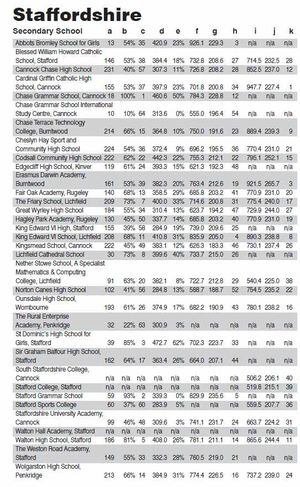
Sandwell - Academies are winners for benchmark grades
Secondary schools in Sandwell rose in the GCSE rankings to 133rd position, although results in the borough's schools are still below the national average.
In 2014, 50.7 per cent of pupils met the required standard for GCSE results, enabling the authority to rise five places on 2013.
The top performing school for GCSE results was the Q3 Academy, where 75 per cent of its 179 pupils walked away with five or more A* to C-grades including English and maths.
George Salter Academy came in second, with 66 per cent of pupils achieving benchmark grades, while Sandwell Academy West came in third.
However, despite the slight improvement in the standings, results across the borough fell from 54.1 per cent over the last year.
The drop in standards has led Sandwell Council leader Councillor Darren Cooper to call a meeting with academy headteachers to discuss plummeting standards after he branded the performance of some academies 'unacceptable.'
